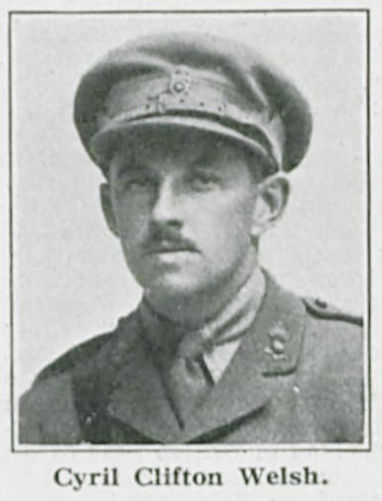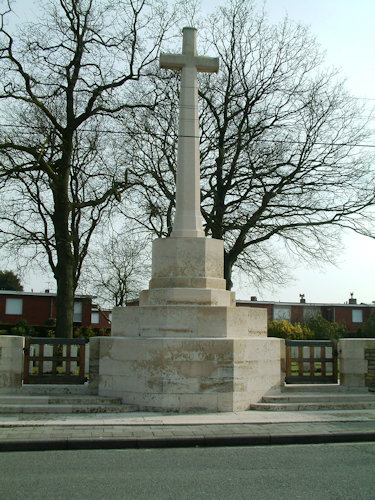Name
Cyril Clifton Welsh
28th October 1889
Conflict
First World War
Date of Death / Age
17/07/1917
29
Rank, Service Number & Service Details
Captain
Royal Field Artillery
"B" Battery, 256th Brigade,
Awards: Service Medals/Honour Awards
1914 /15 Star, British War and Victory medals
Cemetery/Memorial: Name/Reference/Country
POPERINGHE NEW MILITARY CEMETERY
II.D.33
Belgium
Headstone Inscription
Not Researched
UK & Other Memorials
Stained Glass Window, Hitchin Boys Grammar School,
St Mary's Church Roll of Honour (Book), Hitchin,
Biggleswade Town Memorial
Pre War
Cyril was born on 28th October 1889 in Biggleswade, Beds. and baptised there on 8 December 1889. His parents were Robert Crosbie and Mary Laurie Welsh (née Hooper), and they had married on 30 April 1888 . Feast of Saints Peter and Paul, Albury, Surrey. Robert was from Scotland and living in Biggleswade and Mary the daughter of Edmund Lewis Hooker of Albury, Guildford, Surrey.
In 1891 the family were living at High Street, Biggleswade, Beds. Present were both parents: Robert (30) and Mary (27), with Robert working as a general medical practitioner. Their children were: Cyril Clifton Welsh, 11 months old and William L Welsh at 17 weeks. They had three domestic servants cook Ada Castle (23), nursemaid Emma K Hitchcock (17) and housemaid Rose Richardson (15).
Cyril was educated at educated at the Hitchin Grammar School, but the dates are not known, and also at Ditchling and Epsom College and in 1901 he was at the latter, boarding at Eastfield House, , East Street, Ditchling, Sussex where he was boarding with many other boys. His parents were still in Biggleswade, but now at Station Road, Biggleswade. The children present were Margaret J (8) and Ruby J (6). The domestic servants present were cook, Clara E Brown (20) and housemaid Emma L Clark (18).
In 1906 Cyril was indentured in the Merchant Navy, apprenticed to W Price & Co, with his indenture expiring in 1910.
By 1911 the Cyril’s family were still at Station Rd, Biggleswade, Beds. Present were both parents, Robert now working as a physician and surgeon and all the children had left home. The census recorded they had been married for 22 years with 4 children. They still had a cook and housemaid: Martha Mary Smith (29) and Elsie Annie Adams (18). Cyril has not been found in this census and possible was away with the Merchant Navy.
He married Nellie Florence Johnson in 1914 in West Ham.
He has an entry in the De Ruvigny's Roll of Honour and much of the information below is sourced from this.
He volunteered at the outbreak of war joining the 4 Hussars as a Trooper on the 21st August 1914.
Wartime Service
He received a commission and was gazetted Temporary 2nd Lieutenant in the Royal Field Artillery in January 1915. He went to France landing there on 1 December 1915 in November 1915 and was placed on the permanent list and promoted Captain in November 1916.
On the 1st December 1915 he was reputedly killed by a bomb dropped from an aeroplane near Poperinghe and was buried in the cemetery attached to the military hospital there. At the time of his death he seems to have been in ‘D’ Battery of the 256th Brigade of the Royal Field Artillery which was equipped with 4.5" howitzers and was part of the 51st (Highland) Division in the XVlll Corps of the 5th Army. As a Captain he was almost certainly either on the gun positions or a Forward Observation Officer in or near the trenches with the infantry.
This was just before Third Ypres (Passchendaele) and the Battery was positioned about one mile north of Ypres and a mile and a quarter behind the forward trenches, ready to support the infantry attacking towards Kitchener's Wood and to the northeast of St. Julien. Constant shelling from the 12th June reached a crescendo on the 16th July, raining shells and drenching gas, especially the new mustard gas. It was recorded that he was killed in action near Poperinghe on the 17th July 1917. Hertfordshire Express dated 18 August 1917 reported that his death came after he and others were engaged at midnight at a dump unloading and sporting ammunition, when an enemy aeroplane passed over and dropped bombs, killing Captain Welsh and several others engaged at the dump.
He was buried in Plot 2, Row D, Grave 33 in the Poperinghe New Military Cemetery in Belgium. He headstone has a private inscription on the headstone reading "So dearly loved so sorely missed".
Brigade General Oldfield wrote of him "He was a very gallant man and I personally had taken steps to get him a regular commission. . . . he had a tremendous capacity for work." His Commanding Officer, Lieut. Col. Dyson, wrote "He was an invaluable officer of the highest type of courage, well proved on many occasions with wonderful energy and capacity for work.”
He was the husband of Nellie Florence Welsh of 8, Macaulay Road, East Ham, London. His brother, Major W.L. Welsh of the R.A.F., survived the war and was awarded the Distinguished Service Cross, the French Croix de Guerre with palm and the Order of the Crown of Belgium.
Cyril was entitled to the 1914/15 Star, British War and Allied Victory Medals.
Additional Information
Acknowledgments
Adrian Dunne, David C Baines, Jonty Wild



